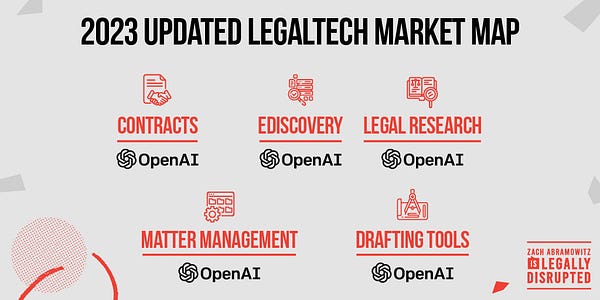Is the AI Going to Replace Your Legaltech?
Software is eating software
AI replacing lawyers has been so oft repeated that it has become a meme. But what if the real AI disruption won’t be the lawyers it displaces, but instead the technology they use?
On Friday, I jokingly shared my updated and revised #legaltech market map on Twitter (also the lead image on this post)
Some people thought it was a joke, some people thought I was being serious. I can’t decide if I was joking or not.
In a recent interview with Bob Ambrogi, Prof Dan Katz and his partner Michael Bommorito quipped that because the release of ChatGPT, technology companies that were built in the last 5-10 years had essentially all become legacy solutions.
Why would this be the case? Couldn’t current technology companies simply incorporate large language models into their product like Microsoft is doing with its release of Copilot? The problem is that no software company other than Microsoft has that kind of penetration with customers or a $10B investment in OpenAI, the makers of ChatGPT.
Think about a company like Toys R Us that was put into bankruptcy because the changing reality of more people buying online. Everything that made Toys R Us special and gave its most were now working against the store’s business model. Similarly, many AI companies have investing in building their own AI for years (the thing that made them special), and now a potentially superior product is widely available for a lower price point. Do you, for example, need an eDiscovery review platform when you can simply ask an AI assistant to go through a large corpus of documents and come back with answers and citations (one of the features in Casetext’s recently released CoCounsel)?
How many #legaltech companies will find themselves in the position of Toys R Us? That is unclear. My assumption is that companies will fall into one of 3 categories:
Not impacted because LLMs simple can’t do what their tech does?
Impacted negatively because LLM’s commodify their offering.
Impacted positively because LLMs supercharge their offering.
So which companies fall into which categories? Stay tuned, this is going to be the story of legal disruption in 2023. And speaking of which, you have now been legally disrupted.






It's going to be dead-simple for a corporate legal department to use LLM tech through Copilot in the Microsoft tools they already use, sitting on a graph of knowledge that's already available and continuously updated. Once DMS systems and legal caselaw and resources are also connected, point solutions are going to have to work very hard to survive.
Of course, there are non-trivial questions to still resolve, such as permissioning sensitive materials that flow into the foundation model, which is paticularly important for law firms (think, ethical walls). But at the current pace, it won't be long ...
Agreed, a strong case for replacement exists. But companies that offer a clear path to migrate from DMS and CLM will come out as winners